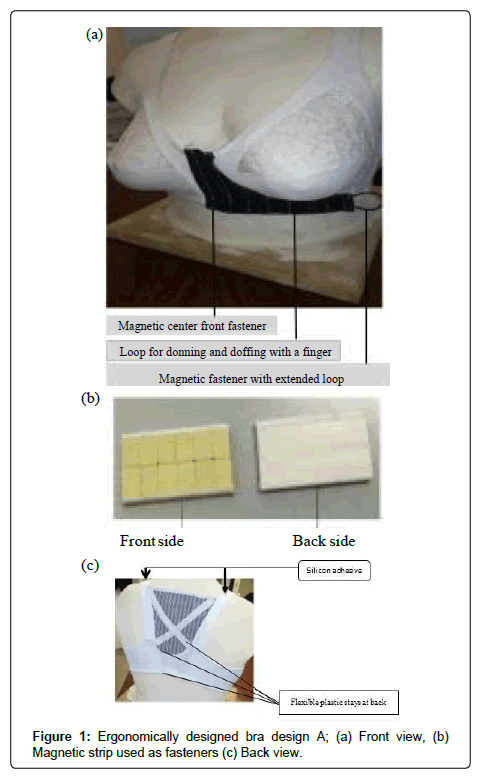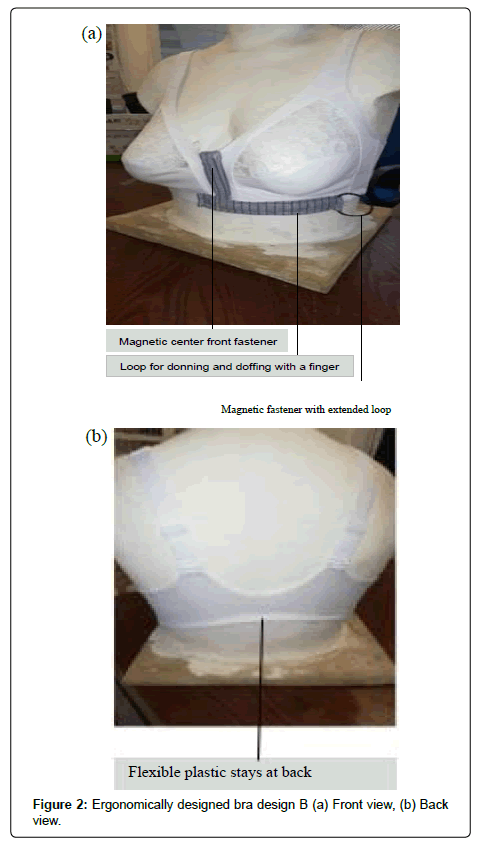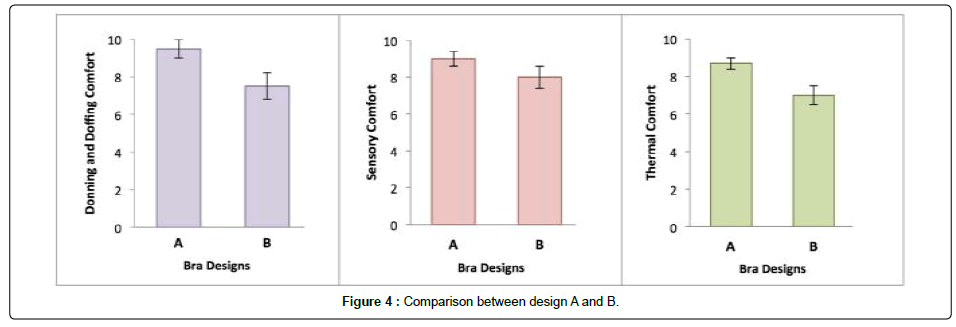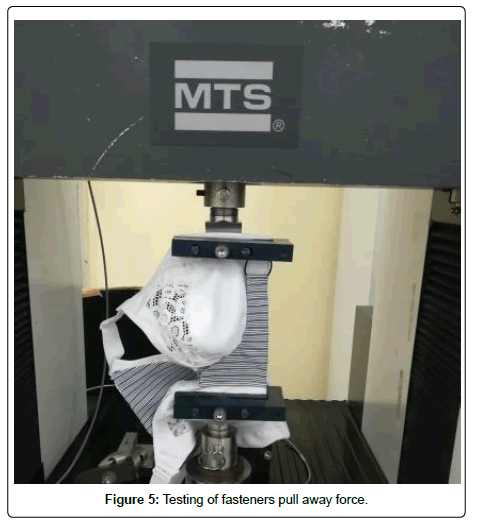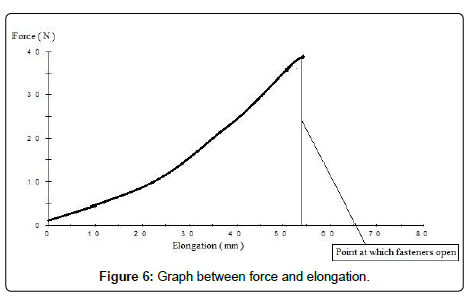Research Article, J Fashion Technol Textile Eng S Vol: 0 Issue: 5
Evaluation on Ergonomically Designed Brassiere for the Females Suffering from Hemiplegia
Imran A*, Drean E, Schacher L and Adolphe D
Laboratory of Physics and Textile Mechanics (LPMT), Department of Textiles and Fibers, University of Haute-Alsace, France
*Corresponding Author : Aqsa Imran
Laboratory of Physics and Textile Mechanics (LPMT), Department of Textiles and Fibers, University of Haute-Alsace | UHA, 11 rue Alfred Werner, 68093 Mulhouse, France
E-mail: aqsa.imran@uha.fr
Received: September 24, 2017 Accepted: October 12, 2018 Published: October 16, 2018
Citation: Imran A, Drean E, Schacher L. Adolphe D (2018) Evaluation on Ergonomically Designed Brassiere for the Females Suffering from Hemiplegia. J Fashion Technol Textile Eng S5:007. doi: 10.4172/2329-9568.S5-007
Abstract
One of the most basic activities of daily living is dressing. As an isolated activity, dressing is complex one, involving not only coordination and dexterity but also balance and a full range of motion in both upper and lower limbs. At times physical limitations complicate self-dressing, which inevitably leads not only to fatigue, but also to frustration. The purpose of this study is to develop the most practical and comfortable brassiere for the females suffering from hemiplegia. An interview schedule was developed to collect the data regarding their body needs, problems faced by them and their preference for functional features. The results are summarized as follows. First, brassiere with easy dressing and undressing function were required. Second, the location of the fasteners should be given more design consideration for easy limb movement. Third, soft and moisture management fabrics with the property of keeping warm were preferred. Based on the results of the interview, two designs were developed and attention was paid to the above three requirements. Double-face knitted fabrics with hydrophobic inner (polyester) and hydrophilic outer (cotton) layers were used to get better thermal insulation and moisture transportation. Flexible magnetic fasteners were used which made it possible for persons with reduced strength, mobility and sensitivity in their hands to manage fastening. Extended bra strap making it possible to handle the closure with one hand. Tests were performed and statistical tools were used to evaluate different designs, and results to reveal that one of the proposed designs was preferred in all aspects.
Keywords: Hemiplegia; Self dressing; Fatigue; Flexible magnetic fasteners; Product development
Introduction
Apoplexy is the old name for Stroke, derived from the ancient Greek language meaning 'struck down violently’. According to the 2013 Global burden of disease study, stroke is the second largest contributor to disability-adjusted life years (113 million disability adjusted life years) in the world after ischemic heart disease, is a major cause of disability, and is the second most common cause of dementia, after Alzheimer disease. Stroke leads to a rapid loss of brain function through a disturbance in the blood supply to the brain and usually causes hemiparesis. Hemiplegics are the persons suffering from hemiplegia i.e. paralysis of one side of body. Paralysis is neuro muscular disease, which causes loss or impairment of motor function in a part of the body due to lesion of the neural or muscular chain leading to complete dysfunction of the affected part. Left-hemispheric ischemic strokes to appear to be more frequent and often have a worse outcome than their right-hemispheric counterparts. If the stroke affected the left side of the brain, the body right side will have problems. Right-handed patients with the left hemiplegia performed all subtests more slowly when using the involved hand, compared to those with the right hemiplegia as right hand is the dominating hand.
After stroke, various dysfunctions frequently influence independence in activities of daily living (ADLs). Motor function impairments in particular have a greater effect than perceptual and cognitive dysfunction on independence in ADLs [1].
Dressing is an ADL in which people with stroke have difficulties achieving independence. According to previous studies, 41% of people require assistance with dressing one month after a stroke, and 36% continue to require assistance two years post stroke [2,3]. Previous studies have revealed that motor function of the affected upper and lower limbs [4] and trunk function [5,6] are involved in independence in dressing. However, few studies have examined the relationship between dressing and motor dysfunction [7]. Many of the disabled people live under the permanent stress of having no choice but to acquire clothes from regular stores. Unlike the majority of the population, the specific needs of disabled people vary according to certain requirements that are triggered by a particular necessity.
Thus, clothing must provide additional comfort at functional and sensory levels, as well as at a psychological one. The persons suffering from hemiplegia have weak muscles, limited small and complex motor movement, which affect the dressing ability and manipulation of fasteners. Such handicapped females, particularly those suffering from hemiplegia, often have difficulties in accessing and removing undergarments, because of their muscular weakness, loss of finger dexterity and/or eye/hand coordination, and limited ranges of motion [4].
All of the researchers worked on outerwear’s or undergarments like panties for handicapped people but no one paid attention on upper body undergarments specially bra for such females. Efforts have been made to identify the problems encountered by the hemiplegics while dressing and undressing to design bra styled for ease of dressing/ undressing having easily manipulable fasteners.
On top of everything, these special textile products must have special functions and be manufactured by using fabrics with special properties, such as:
Certain tactile properties, especially when the product addresses people with sensitive skin;
Thermal comfort, which becomes paramount for females suffering from hemiplegia who spends a lot of time in bed [8,9].
Be able to remove humidity created through the process of perspiration (one of the most widespread problems), which implies optimal humidity absorption and air circulation [10].
Comfort in fabrics is related to three main factors, namely thermo-physiological, sensorial and physiological [11,12]. Thermo-physiological comfort is a general expression of factors such as the thermal properties, water vapour transmission, sweat absorption and drying ability of fabrics [13,14]. The moisture transmission behaviour of a clothing assembly plays a very important role in influencing its efficiency with respect to both thermo-physiological and sensorial body comfort [15,16]. Moisture management property is an important aspect of any fabric meant for apparel, which decides the comfort level of that fabric [17].
An interview schedule was developed to collect the data regarding their body needs, problems faced by them, the preference for functional features. The results are summarized as follows. First, brassiere with easy dressing and undressing functions were required. Second, the location of the fasteners should be given more design consideration for easy limb movement. Third, fabrics with better moisture management property for keeping them warm and dry were preferred.
Based on the results of the interview, two designs as shown in Figure 1 and Figure 2 were developed and attention was paid to the above three requirements.
Double-face knitted fabrics with hydrophobic inner and hydrophilic outer layers made of cotton and polyester was used to get better thermal insulation and moisture transportation.
Flexible magnetic fasteners were used which made it possible for persons with reduced strength, mobility and sensitivity in their hands to manage fasting.
Extended bra strap with front opening making it possible to handle the closure with one hand and without genuine grip function.
Plastic stay added at the backside in order to keep back in shape so that it becomes easy to wear.
Methodology
Clothing for special needs represents a class of functional clothing that is developed to improve the quality of life of disabled people (and not only) whose body shape, size, mobility and dexterity are significantly different from that of the so-called “normal people”.
Reported studies have shown that these groups are very sensitive to the clothing they wear and to their overall personal appearance. The needs of these persons are distinctive and different and thus there is a need for designing clothing specifically engineered to their requirements. Schematic illustration of functional design process has given in below Figure 3.
An interview schedule was developed to collect the data regarding their body needs, problems faced by them, the preference for functional features. The results are summarized as follows. First, brassiere with easy dressing and undressing functions were required. Second, the location of the fasteners should be given more design consideration for easy limb movement. Third, fabrics with better moisture management property for keeping them warm and dry were preferred.
Based on the results of the interview, two designs as shown in Figure 2 and Figure 3 were developed and attention was paid to the above three requirements.
Double-face knitted fabrics with hydrophobic inner and hydrophilic outer layers made of cotton and polyester was used to get better thermal insulation and moisture transportation.
Flexible magnetic fasteners were used which made it possible for persons with reduced strength, mobility and sensitivity in their hands to manage fasting.
Extended bra strap with front opening making it possible to handle the closure with one hand and without genuine grip function.
Plastic stay added at the backside in order to keep back in shape so that it becomes easy to wear.
Results and Discussion
In order to evaluate the design a survey was conducted, females suffering from hemiplegia and a specific panel composed of students and administrative staffs that mimic the handicap of the hemiplegic persons, age ranging from 30 to 60 years participated in this survey. Based on this specific study the results are shown. The survey allowed us to evaluate that the functional features of the developed brassiere (Table 1).
| Characteristics of functional features | Not-Highly Satisfied Satisfied 0 10  |
|
| Assessment of comfort | ||
| Easy to wear with single hand |  |
|
| Easy to fasten with single hand |  |
|
| Donning | Easy to unfasten with single hand |  |
| and | Easy to remove with single hand |  |
| Doffing | Location of fasteners are in optimum grip area |  |
| Comfort | Fasteners are easy to understand and identify |  |
| Fasteners stand body movements without opening |  |
|
| Fasteners have suitable dimensions for handling |  |
|
| Is it time and fatigue free? |  |
|
| Sensory Comfort | Hand or feel of fabric |  |
| Pressure against skin |  |
|
| Aesthetic Comfort | Aesthetic value of bra |  |
Table 1: Survey form.
These results illustrate that Design “A” is the prefered design as shown in Figure 4. The main reasons for this preference is described below,
The design of the back and the use of more numbers of stays at back which keep it straight while wearing,
The shape of the front extended loop as it provides more grip for a person to fasten it with single hand.
The use of silicon adhesive at shoulder strap which avoid slippage of shoulder strap while wearing
To evaluate the magnetic fasteners grip, i.e. that these have enough strength to keep it stay fastened, we observe patients in different body postures wearing bra. Normally the patients suffering from hemiplegia not have much physical activity. In respiration, the increase in circumference is up to 6 cm.
In addition, tensile strength was measured in order to find pull away force of the magnetic fasteners. Tensile strength tester was used in order to find magnetic pull away force of the magnetic strip used as fasteners, at the velocity rate of 100 mm/s. 10 samples were tested and results are shown below in Table 2.
| Sr. no | Force maximum N | Elongation at which fasteners open mm |
|---|---|---|
| 1 | 39 | 50.0 |
| 2 | 42 | 50.3 |
| 3 | 38 | 50.5 |
| 4 | 32 | 51.2 |
| 5 | 39 | 51.0 |
| 6 | 39 | 50.1 |
| 7 | 35 | 50.4 |
| 8 | 46 | 50.0 |
| 9 | 38 | 50.5 |
| 10 | 40 | 50.2 |
| Mean | 39 | 50.4 |
| Standard deviation | 3.7 | 0.4 |
| % COV | 9.6 | 0.80 |
Table 2: Results of tensile test.
We performed the test on 1/4th part of the bra as shown in Figure 5 and graph above shows that it stayed fastened till 5 cm (50 mm) elongation as shown in Figure 6. This means it can stay fastened even if the extension is of 20 cm.
Conclusion
This study illuminated the undergarments specially brassiere design problems that prevented females with mobility disabilities in accessing and removing undergarments, because of their muscular weakness, loss of finger dexterity and/or eye/hand coordination, and limited ranges of motion. This research continues to support the need for an innovative design approach to help eliminate the clothing-related barriers and reduce the social stigma associated with adaptive, functional clothing for people with disabilities and impairments.
Acknowledgment
Authors acknowledge Higher Education Commission (HEC) Pakistan for the doctoral scholarship and Mme Aude COMPAN, working as Occupational therapist in Mulhouse Hospital, for her support.
References
- Mercier L, Audet T, Hebert R, Rochette A, Dubois MF (2001) Impact of motor, cognitive, and perceptual disorders on ability to perform activities of daily living after stroke. Stroke 32 : 2602–2608.
- Edmans JA, Lincoln NB (1990) The relationship between perceptual deficits after stroke and independence in activities of daily living. Br J Occup Ther 53 : 139–142.
- Edmans JA, Towle D, Lincoln NB (1991) The recovery of perceptual problems after stroke and the impact on daily life. Clin Rehabil 5: 301–309.
- Walker MF, Lincoln NB (1991) Factors influencing dressing performance after stroke. J Neurol Neurosurg Psychiatry 54: 699–701.
- Saito Y, Toshima M, Nori K, Kimura N (2012) Factors affecting upper-body ability in post-acute stroke patients: A functional assessment. Sagyouryouhou 31: 134–140.
- Fujita T, Sato A, Togashi Y, Kasahara R, Ohashi T, et al. (2015) Contribution of abdominal muscle strength to various activities of daily living of stroke patients with mild paralysis. J Phys Ther Sci 27: 815–818.
- Walker CM, Walker MF (2001) Dressing ability after stroke: A review of the literature. Br J Occup Ther 64 : 449–454.
- Amrit UR (2007) Bedding textiles and their influence on thermal comfort and sleep. AUTEX Res J: 252-254.
- Zeinab SAR, Saad MM, El-Shakanker M, Hanafy I (2006) Textile fabrics as thermal insulators. AUTEX Res J 6: 148-161.
- Dutkiewicz KJ (2006) Cellulosic fiber for odor and ph control. AUTEX Res J 6: 91-101.
- Onofrei E, Rocha AM, Catarino A (2011) The influence of knitted fabrics’ structure on the thermal and moisture management properties. J Eng Fibers Fabr 6: 10–22.
- Bivainyte A, Mikucˇioniene D (2011) Investigation on the air and water vapour permeability of double-layered weft knitted fabrics. Fibers Text. Eastern Eur 19: 69–73.
- Demiryurek O, Uysalturk D (2013) Thermal comfort properties of viloft/cotton and viloft/polyester blended knitted fabrics. Text Res J 83: 1740– 1753.
- Senthilkumar P (2009) Study of comfort characteristics of cotton hollow yarn knitted fabrics.
- Song G (2011) Improving comfort in clothing. Woodhead Publishing Limited, Cambridge, USA.
- Tang KM, Kan CW, Fan JT (2015) Assessing and predicting the subjective wetness sensation of textiles: subjective and objective evaluation. Text Res J 85: 838–849.
- Das A, Shabaridharan R, Biswas B (2011) Study on heat and moisture vapour transmission characteristics through multi-layered fabric ensembles. Indian J Fiber Text Res 36: 410–444.
 Spanish
Spanish  Chinese
Chinese  Russian
Russian  German
German  French
French  Japanese
Japanese  Portuguese
Portuguese  Hindi
Hindi 